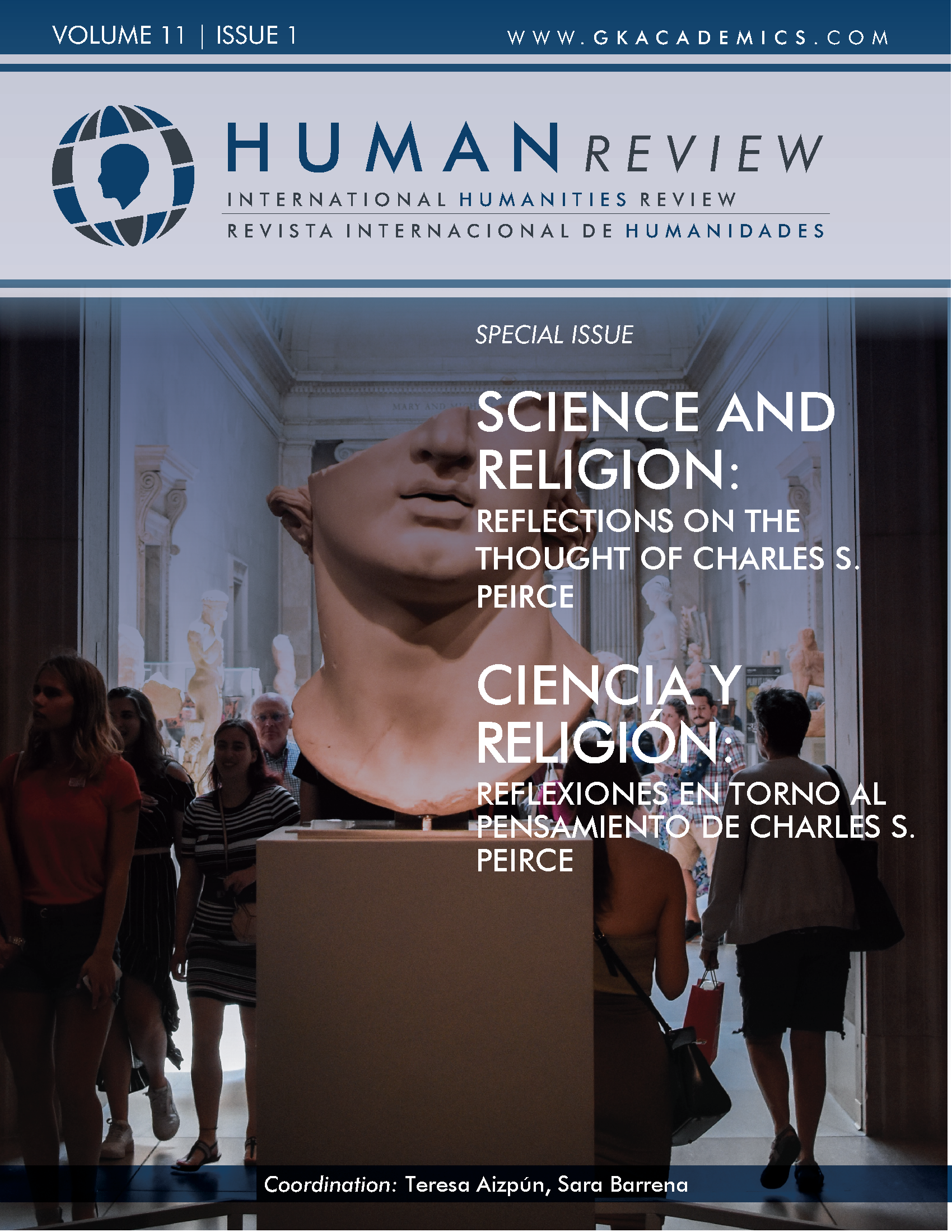The Varieties of Abductive Experience
DOI:
https://doi.org/10.37467/gkarevhuman.v11.3220Keywords:
Abduction, Default Mode Network, Experience, James, Musement, Peirce, ReligionAbstract
Following the Peirce’s proposal drawn in the Neglected Argument, here we focus on the equivalence, from the generative and methodological point of view, of what we will call the religious and scientific abductive experiences. To articulate these connections, we also rely on William James's Gifford Lectures (1901-1902) collected under the title The Varieties of Religious Experience. Moreover, we study extensively the universality of the Musement which is related to the mental processes that lead to the generation of the most creative abductions; finally, we fully identify the Musement with a recent discovery of neuroscience, the brain’s default mode network.
References
Aliseda, A. (2006). Abductive Reasoning. Logical Investigations into Discovery and Explanation. Springer.
Anderson, D. R. (1986) The Evolution of Peirce’s Concept of Abduction. Transactions of the Charles S. Peirce Society, 22(2), 145–164.
Anderson, D. R. (1987). Creativity and the philosophy of C.S. Peirce. Martinus Nijhoff. DOI: https://doi.org/10.1007/978-94-015-7760-1
Anderson, D. R. (2005). The esthetic attitude of abduction. Semiotica, 153(1), 9-22. DOI: https://doi.org/10.1515/semi.2005.2005.153-1-4.9
Andreasen, N. C., O’Leary, D. S., Cizadlo, T., Arndt, S., Rezai, K., Watkins, G. L., Boles Ponto, L. L. y Hichwa, R. (1995). Remembering the past: Two facets of episodic memory explored with positron emission tomography. American Journal of Psychiatry, 152(11), 1576-1585. DOI: https://doi.org/10.1176/ajp.152.11.1576
Aranguren, J. L. (1999). Prólogo. En W. James. (1902). Las variedades de la experiencia religiosa (pp. 5-7). Ediciones Península.
Barrena, S. (1996). Un argumento olvidado en favor de la realidad de Dios. Introducción, traducción, introducción y notas de Sara F. Barrena. Cuadernos de Anuario Filosófico. Universidad de Navarra.
Barrena, S. (2003). La creatividad en Charles S. Peirce: Abducción y Razonabilidad. [Tesis doctoral]. Universidad de Navarra.
Barrena, S. (2008). El Argumento Olvidado de C. S. Peirce cien años después: Dios, juego y símbolo. Methodus, 3, 22-45. DOI: https://doi.org/10.5771/0718-2775-2008-3-22
Beaty, R. E., Benedek, M., Wilkins, R. W., Jauk, E., Fink, A., Silvia, P. J., Hodges, D. A., Koschutnig, K. y Neubauer, A. C. (2014). Creativity and the default network. Neuropsychologia 6, 92-98. DOI: https://doi.org/10.1016/j.neuropsychologia.2014.09.019
Buckner, R. L., Andrews-Hanna, J. R. y Schacter, D. L. (2008). The Brain’s default network. Anatomy, function, and relevance to disease. Annals of the New York Academy of Sciences, 1124, 1-38. DOI: https://doi.org/10.1196/annals.1440.011
Caleb Clanton, J. (2014). The structure of C. S. Peirce’s neglected argument for the reality of God: A critical assessment. Transactions of the Charles S. Peirce Society, 50(2), 175–200. DOI: https://doi.org/10.2979/trancharpeirsoc.50.2.175
Duarte, A. (2016). La abducción; una aproximación dialógica. [Tesis Doctoral]. Universidad Complutense de Madrid.
Duarte, A. (2019). La creatividad ¿abductiva? de la memoria. Límite, Revista Interdisciplinaria de Filosofía y Psicología, 14. DOI: https://doi.org/10.4067/S0718-50652019000100208
Duarte, A. (2020). Musement: The activity of the brain’s default mode network. Semiotica, 233, 145-158. DOI: https://doi.org/10.1515/sem-2018-0118
Eco, U. y Sebeok, T. A. (Eds.). (1988). The sign of three: Dupin, Holmes, Peirce. Indiana University Press.
Ellamil, M., Dobson, C., Beeman, M. y Christoff, K. (2012). Evaluative and generative modes of thought during the creative process. NeuroImage, 59, 1783-1794. DOI: https://doi.org/10.1016/j.neuroimage.2011.08.008
Fann, K. T. (1970). Peirce’s Theory of Abduction. Ed. Martinus Nijhoff – The Hague. DOI: https://doi.org/10.1007/978-94-010-3163-9
Génova, G. (1997). Charles S. Peirce: La lógica del descubrimiento. Cuadernos de Anuario Filosófico, 45. Universidad de Navarra.
Gusnard, D. A. y Raichle, M. E. (2001). Searching for a baseline: Functional imaging and the resting human brain. Nature Reviews Neuroscience, 2, 685-694. DOI: https://doi.org/10.1038/35094500
Hintikka, J. (1998). What is Abduction? The Fundamental Problem of Contemporary Epistemology. Transactions of the Charles S. Peirce Society, XXIV(3), 503-533.
James, W. (1999). Las variedades de la experiencia religiosa. Ediciones Península.
Johnson, R. H. y Blair, J. A. (2021). Lógica Informal: una panorámica. En L. Vega Reñón (Eds.), La teoría de la argumentación en sus textos: una antología. (pp. 233-252). Palestra.
Niño, D. (2007). Abducting Abduction. Avatares sobre la comprensión de la Abducción de Charles S. Peirce. [Tesis Doctoral]. Universidad Nacional de Colombia.
Nubiola, J. (1998). Walker Percy y Charles S. Peirce: abducción y lenguaje. En C. S. Peirce y la abducción. Analogía Filosófica, XII/1, 3-8.
Nubiola, J. (2004). C. S. Peirce y la abducción de Dios. Tópicos, 27, 73-93. DOI: https://doi.org/10.21555/top.v27i1.246
Nubiola, J. (2005). Abduction or the Logic of Surprise. Semiotica, 153(1/4), 117-130. DOI: https://doi.org/10.1515/semi.2005.2005.153-1-4.117
Panesa, R. T. (1996). Science and Religion in Charles S. Peirce. [Tesis Doctoral]. Universidad de Navarra.
Peirce, C. S. (1931-1958). Collected Papers, vols. 1-8. C. Hartshorne, P. Weiss y A. W. Burks (Eds.), Harvard University Press. (CP).
Peirce, C. S. (1966). The Charles S. Peirce Papers. 32 rollos de microfilms de los manuscritos conservados en la Houghton Library. Harvard University Library, Photographic Service. (MS).
Santaella, L. (1998). La evolución de los tres tipos de argumento: Abducción, inducción y deducción. En C. S. Peirce y la abducción. Analogía Filosófica XII/1, 9-20.
Smart, A. (2015). El arte y la ciencia de no hacer nada. El piloto automático del cerebro. Clave Intelectual.
Downloads
Published
How to Cite
Issue
Section
License
Those authors who publish in this journal accept the following terms:
- Authors will keep the moral right of the work and they will transfer the commercial rights.
- After 1 year from publication, the work shall thereafter be open access online on our website, but will retain copyright.
- In the event that the authors wish to assign an Creative Commons (CC) license, they may request it by writing to publishing@eagora.org









